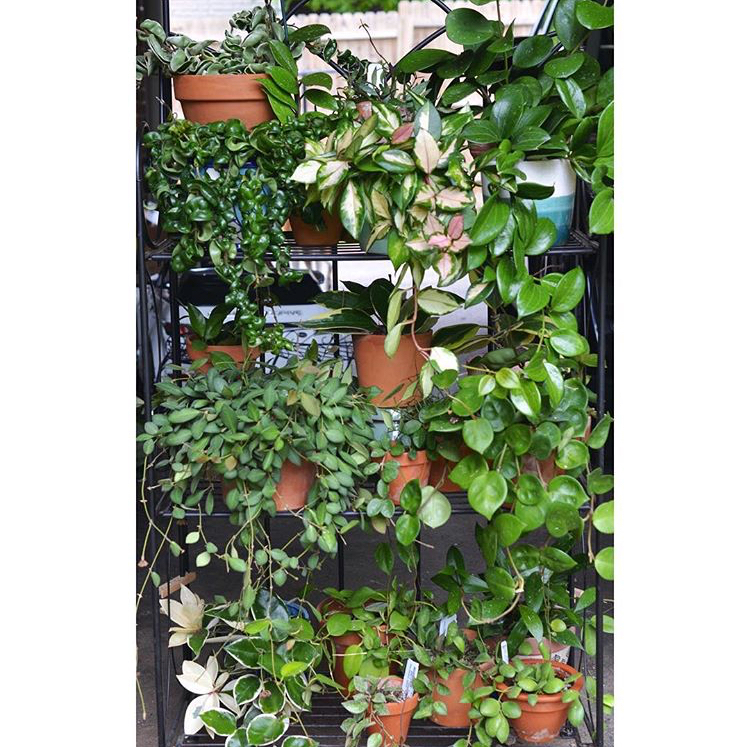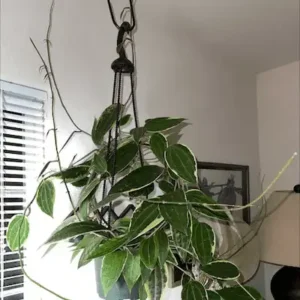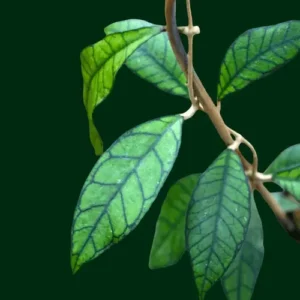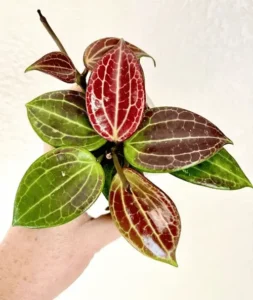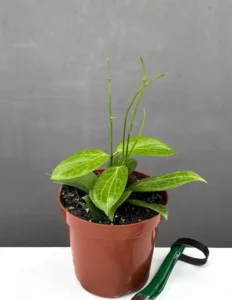Introduction
In this comprehensive guide, I’ll explore the most common indoor Hoya plants, how to care for them, and tips on growing them successfully in your home. Hoyas, also known as wax plants due to their glossy, thick leaves, are a popular choice for indoor plant enthusiasts. With their trailing vines, fragrant flowers, and resilient nature, Hoyas add a touch of elegance to any space. Native to tropical regions in Asia and Australia, these plants are relatively easy to care for, making them ideal for both novice and experienced gardeners.
Overview of Hoya Plants
Hoyas belong to the Apocynaceae family, with over 500 species ranging from trailing vines to compact shrubs. What sets them apart are their thick, waxy leaves and star-shaped flowers that come in various colors and fragrances. These plants are typically slow-growing, but once established, they can live for many years, providing long-lasting greenery and beauty.
Characteristics
-Growth Habit
Trailing vines or climbing.
-Leaves
Thick, glossy, often waxy.
-Flowers
Star-shaped, usually fragrant, and in clusters.
-Light Requirements
Bright, indirect light.
-Watering
Allow soil to dry out between waterings.
-Temperature
Prefer warmth and humidity.
Why Choose Hoyas?
Hoyas are a favorite for indoor growing because they are low-maintenance and adaptable to different conditions. They thrive in bright indirect light but can tolerate lower light situations, though they may not flower as much. Their thick leaves store water, making them drought-tolerant and perfect for people who occasionally forget to water their plants. Additionally, Hoyas are excellent choices for hanging baskets or trellises due to their vining nature.
Hoya Carnosa
One of the most well-known species of Hoya, Hoya carnosa, is a versatile, low-maintenance plant. Its fleshy, oval-shaped leaves are a deep green, and the plant produces clusters of small, fragrant pink flowers with a red center. It is one of the most popular and common indoor Hoya plants.
Care Tips
- Light: Prefers bright, indirect light but can tolerate some lower light conditions.
- Watering: Water thoroughly when the soil is dry to the touch. Avoid overwatering as it can lead to root rot.
- Temperature: Ideal range is between 60-85°F (15-29°C). Avoid exposing it to cold drafts.
Hoya carnosa can be grown in hanging baskets or on a trellis to show off its trailing vines. It’s a slow grower but can live for decades, making it a plant you can pass down through generations.
Hoya Kerrii (Sweetheart Hoya)
The Hoya kerrii, often called the “Sweetheart Hoya” or “Valentine Plant” due to its heart-shaped leaves, is a popular gift plant around Valentine’s Day. While the single-leaf cuttings are commonly sold, these can take years to grow into a vine. The full plant produces clusters of white flowers with pink centers.
Care Tips
- Light: Needs bright, indirect light for optimal growth.
- Watering: Water when the soil is dry. Hoya kerrii can tolerate periods of drought thanks to its succulent-like leaves.
- Temperature: It prefers temperatures between 65-80°F (18-27°C).
Due to its slow-growing nature, the Hoya kerrii is perfect for small spaces and makes a charming, low-maintenance addition to any home.
Hoya Pubicalyx
The Hoya pubicalyx (storyteller plant) is known for its fast-growing vines and unique foliage. Its long, narrow leaves often have silver or pink splashes, giving it a striking appearance. The flowers of Hoya pubicalyx range from deep red to pale pink and are highly fragrant.
Care Tips
- Light: Thrives in bright, indirect light but can tolerate some morning sun.
- Watering: Water thoroughly, allowing the top 1-2 inches of soil to dry out before watering again.
- Temperature: Prefers temperatures between 60-85°F (15-29°C).
This Hoya species is more vigorous than others, making it an excellent choice if you want a plant that grows quickly and produces abundant flowers.
Hoya Australis
Hoya australis is another popular indoor variety known for its robust growth and fragrant white flowers. The plant has glossy, oval-shaped leaves that are dark green. Its clusters of flowers can bloom several times a year under the right conditions.
Care Tips
- Light: Needs bright, indirect light to encourage blooming.
- Watering: Water when the soil dries out. Be careful not to overwater as it can lead to fungal issues.
- Temperature: Keep in temperatures between 65-80°F (18-27°C). It enjoys higher humidity levels but can tolerate typical indoor environments.
Hoya australis is often grown in hanging baskets or allowed to climb on trellises, where it can showcase its lush vines and frequent blooms.
Hoya Obovata
With its round, thick leaves, Hoya obovata is one of the most striking Hoya species. The leaves often have splashes of silver, and the plant produces clusters of pale pink flowers that emit a sweet fragrance. It is one of the common indoor Hoya plants.
Care Tips
- Light: Prefers bright, indirect light but can handle some morning sun.
- Watering: Allow the soil to dry out between waterings. Overwatering can lead to root rot.
- Temperature: Ideal temperatures range from 60-80°F (16-27°C).
This plant’s unique foliage makes it a great conversation starter and a standout in any indoor plant collection.
Hoya Retusa
For those looking for something a bit different, Hoya retusa offers thin, grass-like leaves and small, single white flowers with a red center. It has a quirky, minimalist appearance compared to the more traditional, waxy-leaved Hoyas.
Care Tips
- Light: Likes bright, indirect light but can tolerate lower light levels.
- Watering: Keep the soil evenly moist, but not waterlogged. Water more frequently during the growing season.
- Temperature: Prefers temperatures between 60-75°F (16-24°C).
Hoya retusa’s unique shape makes it an interesting addition to any indoor garden, especially for those who enjoy unusual plant forms.
General Hoya Care Tips
No matter the variety of Hoya, there are some general care tips to keep your plant thriving. Here are some general care tips for common indoor hoya plants.
1. Light Requirements
Hoyas love bright, indirect light. If you want your Hoya to flower, it’s crucial to provide ample light. A spot near an east or west-facing window is ideal. While some species can tolerate lower light, they may not bloom as prolifically in dimmer conditions.
2. Watering
Hoyas are drought-tolerant plants due to their succulent-like leaves. The key to watering Hoyas is to let the soil dry out between waterings. Overwatering can lead to root rot, so it’s important to avoid leaving your Hoya in soggy soil. Use a well-draining potting mix and pots with drainage holes to prevent excess moisture buildup.
3. Temperature and Humidity
As tropical plants, Hoyas prefer warmer temperatures between 60-85°F (15-29°C). While they can tolerate typical indoor humidity levels, they will thrive in higher-humidity environments, especially when blooming. Misting your plant or placing it near a humidifier can help mimic its native habitat.
4. Fertilizing
Feed your Hoya with a balanced liquid fertilizer during the growing season (spring and summer). Fertilize once a month to encourage healthy growth and flowering. Hoyas do not need as much fertilizer in the fall and winter when growth slows down.
5. Pruning and Propagation
Pruning Hoyas helps maintain their shape and encourages bushier growth. You can also propagate your plant by taking cuttings. Simply cut a stem below a node, allow it to dry for a few hours, and then place it in water or soil to root. Hoyas are relatively easy to propagate, making them great plants to share with friends.
Common Problems and Solutions
here is a detailed list of common problems and solutions to common indoor hoya plants.
1. Yellowing Leaves
Yellow leaves are often a sign of overwatering. Ensure your plant is in well-draining soil and that you’re allowing the top layer of soil to dry out before watering again.
2. No Flowers
If your Hoya isn’t blooming, it may need more light. Moving it to a brighter spot or providing artificial growth lights can encourage flowering. Keep in mind that some Hoyas take several years to bloom, so patience is key.
3. Pests
Hoyas are generally pest-resistant, but they can occasionally attract mealybugs, spider mites, or aphids. Wipe down the leaves with a damp cloth or use insecticidal soap to get rid of pests.
FAQs What is the most common Hoya houseplant? Hoya carnosa is the most common and popular hoya variety for indoor gardening. It can be found at many nurseries and indoor plant shops. It is also expensive due to its limited availability and high demands from collectors due to its large variegation. What is the easiest Hoya to grow indoors? Hoya australis is the easiest hoya to grow indoors compared to other hoyas. It has a mind of its own. The plant has glossy, oval-shaped leaves that are dark green. Its clusters of flowers can bloom several times a year under the right conditions. Apart from basic care, it requires little to no attention. Is Hoya a good indoor plant? Hoyas are a favorite for indoor growing because they are low-maintenance and adaptable to different conditions. They thrive in bright indirect light but can tolerate lower-light situations. Additionally, Hoyas are excellent choices for hanging baskets or trellises due to their vining nature. |
Conclusion
Hoyas are a wonderful addition to any indoor plant collection, offering unique foliage, beautiful flowers, and minimal maintenance. Whether you’re drawn to the heart-shaped leaves of Hoya kerrii or the fast-growing vines of Hoya pubicalyx, there’s a Hoya for every plant enthusiast. By following the care tips outlined in this guide, you can enjoy the beauty and fragrance of these tropical plants in your home for years to come.

